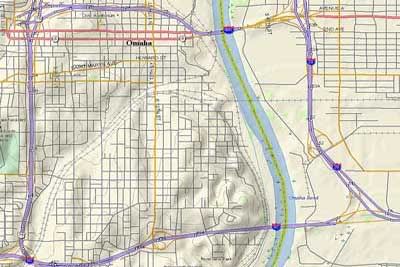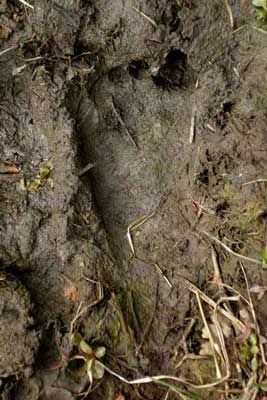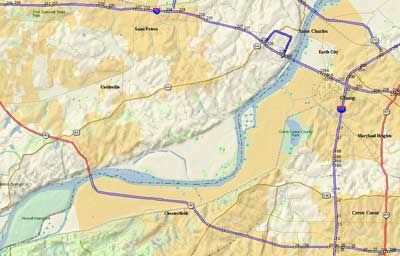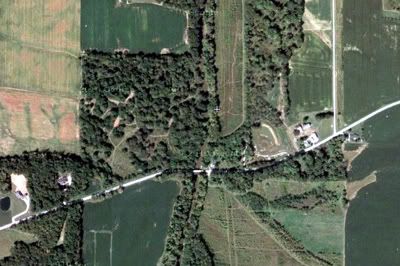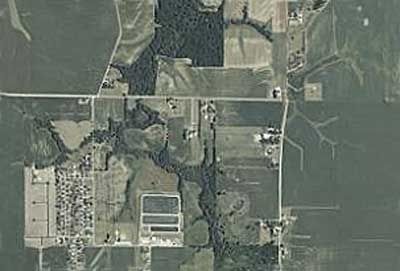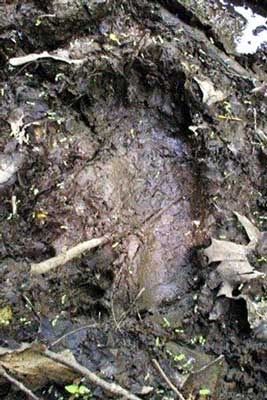The Deer Swath
A Sand County Almanac With Essays on Conservation from Round River by Aldo Leopold was first published posthumously in 1949 with certain additions in later additions. It has become a classic read for those interested in conservation and the environment. I first read this small book over forty years ago. If you have not read it I wholeheartedly encourage you to do so.
Within the book there is one small essay entitled The Deer Swath. I found it summed up my thoughts about those of us who spend time in the woods observing nature and how we perceive what we see and hear. We all have different areas in which we are better than others. My chief interest is sounds, whether bird or mammals while my wife is busy concentrating on looking for tracks in the dust. She is always saying “What
bird, I didn’t hear anything” while I could have a herd of elephants walk through the area and not notice the footprints. I have a friend in New Mexico who excels at looking for elk and deer sign and another friend here in Illinois who is quite adept at looking at ‘sign” as described by the author.
We can not all be good at everything so my advice is for you to have several friends with you as you do your research and concentrate on those areas that are of particular interest to you and allow your friends to concentrate on their areas of interest. The correct dog can be a great asset in the woods. With keen senses my Karelian Bear Dog many times has alerted me to the fact that we were not alone in our section of forest.
The Deer Swath an excerpt from A Sand County Almanac – published June 1989
When the deer hunter sits down he sits where he can see ahead, and with his back to something. The duck hunter sits where he can see overhead, and he behind something. The non-hunter sits where he is comfortable. None of these watches the dog. The bird hunter watches only the dog, and always knows where the dog is, whether or not visible at the moment. The dog’s nose is the bird hunter’s eye. Many hunters who carry a shotgun in season have never learned to watch the dog, or to interpret his reactions to scent.
There are good outdoors men who do not conform to these categories. There is the ornithologist who hunts by ear, and uses the eye only to follow up on what his ear has detected. There is the botanist who hunts by eye, but at much closer range; he is a marvel at finding plants, but seldom sees birds or mammals. There is the forester who sees only trees, and the insects and fungi that prey upon trees; he is oblivious to all else. And finally there is the sportsman who sees only game, and regards all else as of little interest or value.
There is one illusive mode of hunting which I cannot associate exclusively with any of these groups: the search for scats, tracks, feathers, dens, roostings, rubbings, dustings, diggings, feedings, fightings, or preyings collectively known to woodsmen as ‘reading sign.’ This skill is rare, and too often seems to be inverse to book learning.
The Interview
Many bigfoot researchers are leery of giving interviews to the press. The main emphasis should be about the undocumented upright walking North American primate not about the researchers.
Search For Bigfoot – A Documentary
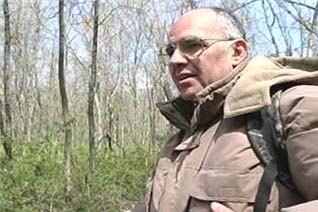
My eldest son is a pastor of a church in Columbia, Missouri. He contacted my wife early in February about allowing a couple of University of Missouri students to spend the night. They were traveling to Bowling Green, Ohio for a church conference and we were conveniently located halfway between Ohio and Missouri. As an aside, he also mentioned that Peggy was interested in interviewing me about my bigfoot research for a class project. I reluctantly agreed, not thinking much about it.
I was a little surprised when they arrived and she set up a video-camera. She did an impromptu interview as I showed her some of my footcasts and recording equipment. I took them out sound-blasting later in the evening and did hear and record some distant howls.
Two months later my son again contacted me and asked if I would allow her to tag along in my research area to see what I do when I am looking for bigfoot evidence. I again agreed and met Peggy, a school friend of Peggy’s, and my son and his wife at the park.
We spent about an hour and a half walking through some areas where I have found footprints and recorded several vocalizations. I did ask if I could have a copy of the DVD when she finished. She said of course.
Saturday I received my copy of the DVD. I was a little taken aback and disappointed that the focus of the short documentary was on the sincerity and saneness of me as a researcher and not on the true subject which is bigfoot / sasquatch.
Man or Beast?
One question that continues to plague bigfoot researchers is “What is this animal, is it a man (albeit different or primitive) or is it just an ape?”
Man has always had to cope with uncertain feelings when it comes to apes and monkeys. We can not gaze into the eyes of a chimp at the zoo and not have some thoughts about our similarities.
Two thousand years ago when Europeans were first exposed to seeing monkeys, it was easy to say “Well we are not closely related, they have tails, walk on all fours, are covered with hair and have no language.” When stories of chimps and gorillas started coming out of Africa, disbelief was common. Here was a group of animals that had no tail, walked closer to upright and looked more human-like. The first “body”
presented to science surely was a momentous event.
So how does this all relate to bigfoot studies? We are confronted with an animal that –
1. Is upright walking (Patterson-Gimlin, Memorial Day, and Freeman films).
2. Has footprints that are somewhat similar to mans as shown by many photographs and footprint casts.
3. Is very vocal, whether these sounds are related to true language or is simply mimicry is open to debate.
4. Has a highly social family structure as reported by eye witness accounts.
5. Facial features look more human-like than apelike. I have interviewed over two hundred witnesses that have had a bigfoot encounter. Of those individuals who have seen the face, almost all of them emphasized its human-like characteristics.
So where does this leave us with the question as to whether bigfoot is man or beast? This debate has been
going on for decades and will only intensify as new films, audio recordings and someday a body is produced.
Perhaps the question should be “What is Man?”
Mankind cannot be defined simply by being intelligent, using tools and language or being bi-pedal.
The final answer can only come from the Bible. We read in Genesis 1:27
“So God created man in his own image, in the image of God he created him;male and female he created them.”
Only man is aware of God and only man is capable of fellowshipping with Him through a right personal relationship through Christ. .
Ephesians 4:24
“and to put on the new self, created to be like God in true righteousness and holiness.”
So friends, it is your decision what you will believe, for myself I believe what separates man from all the animals, whether it be monkey, ape or bigfoot is that only man was created in the image of God and only man is capable of a personal relationship with Jesus Christ, as our Lord and Savior.
References:
Special thank you to:
Pastor Dale B. Huelsman
Bethany Lutheran Church
Wellington, Ohio
A Short Explanation of Dr. Martin Luther’s Small Catechism with
An American Translation Text – A Handbook of Christan Doctrine.
Christian News – New Haven, Missouri 63068
A Summary of Christan Doctrine by Edward W.A. Koehler
Concordia Publishing House, St.Louis
How is Man Created in God’s Image?
Come Reason Ministries
BibleGateway.com
http://www.biblegateway.com/
Wilderness Paradox
One concept that I see being repeated over and over again is that if there is a large bi-pedal ape in North America it must live in only the most remote, secluded wilderness areas. Commonly areas pointed to as likely habitat are the Pacific Northwest, British Columbia, Northern California or if “back
East”, only inaccessible mountainous terrain.
But do witness reports really bear out this assumption?
Let’s take a look at several reports that have been posted by the BFRO, The Bigfoot Field Researchers Organization.
Omaha, Nebraska
Various sightings near the Missouri River in Omaha, Nebraska.
I interviewed this witness. Although the report only goes into recent activity she told me that her family has had several sightings and heard vocalizations going back as far as the early 1960’s. What is significant is that this area is bounded on all four sides by major thoroughfares: I-480 on the west and north, I-29 on the east, I-80 on the south. It is also within 1 1/2 miles of the central district of Omaha, Nebraska.
Of special note is that Marlin Perkins who hosted Mutual of Omaha’s Wild Kingdom made a trip to the Himalayas with Sir Edmund Hillary in 1960 to check out reports of the Yeti. While on that trip they examined a supposed Yeti scalp that turned out to be a hoax. Perhaps they should have saved
their money, stayed home and talked to local witnesses in Omaha.
Topeka, Kansas
Hiker finds footprint near Topeka, Kansas.
What is significant about this report is the excellent picture that he was able to obtain of a possible juvenile bigfoot print. The exact location although not stated is within a couple miles of downtown Topeka and along the Kansas River.
St.Louis County, Missouri
Bow hunter observes animal in Creve Coeur bottoms.
This report comes from an area that is 15 miles from downtown, St.Louis, Missouri and along the Missouri River. It also is only a couple of miles from very populated suburbs in west St.Louis County. This area is bounded on the west and south by I-40, on the north by I-70 and east by I-270.
Madison County, Illinois (unpublished)
This rural location in Madison County, Illinois has been the site of ongoing bigfoot sightings. It is near a small creek and approximately 15 miles from the Mississippi River. I did an on-site investigation and saw several sets of footprints.
Central Illinois. (unpublished)
Another rural location in Central Illinois. This site is also located on a small wooded creek that flows through corn and soybean fields. It is located 13 miles from the Sangamon River. Numerous whistles, woodknocks and howls have been recorded at this site.
Lee County, Illinois
Hikers find footprint along Franklin Creek.
This footprint was found along a small wooded creek in an agricultural area of Northern Illinois. It is located 5 miles from the Rock River.
Food – Water – Cover
The important factors for possible bigfoot habitat seem to be wooded streams or river systems and an adequate food supply, particularly a large deer population. Reports continue to come in whether they are close to major urban centers or agricultural areas.
It has been stated that the Pacific Northwest has a resident population of bigfoot on every watershed. A growing number of researchers are gradually coming to realize that perhaps it is the same situation east of the Rockies.
See How They Run
DB Donlon
One of the main questions plaguing bigfoot researchers is the old perennial, “If bigfoot exists, why haven’t we caught one?” This is a serious question and it deserves serious consideration. Until recently, there weren’t many answers, either. At least, not available to the public. But privately researchers have been sharing information gathered over the years that suggest bigfoot has some abilities beyond what we might have expected.
Unpublished reports that I’ve been privy to suggest that bigfoot can keep up with a car moving at a high rate of speed. These reports are unpublished because, as anecdotal evidence, they don’t count for much by themselves. People can make mistakes, after all — perhaps they weren’t going as fast as they thought, or maybe they didn’t see what they thought they saw. Anytime a report like that challenges conventional wisdom, the prudent thing to do is to wait until you get a verified report that supports it.
I think maybe that happened this summer with the Pine Ridge Reservation sightings. I’m thinking in particular about the police officer who wrote that he had observed a bigfoot running while he pursued it in his car. To quote him (from a post on the bigfootforums.com,) “I then continued my chase but he was just too quick. I was traveling around sixty miles an hour and he was still ahead of me.”
That seems pretty fast, but I know of at least two other, independent reports that state a bigfoot kept up with a car moving at 55 mph, and I’ve read others which mention lower, but still significant figures. What I’d like for the readers of StanCourtney.Com to do, if they are inclined, is to help us come up with more cases of bigfoot observed moving faster than we thought they could go. How good a case can we build for it? If you have any cases, or know if any in the many books written about bigfoot – anything at all, please let us know, either by leaving a post on the North American Bigfoot Forums, or by emailing me directly at dbdonlon AT gmail DOT com. (You know how to turn that into a real email address, I trust..) or contact Stan Courtney.
Think for a minute about what this tidbit of information could help us explain. Why can’t we catch them? For one thing, they move much faster than we ever thought they could. And how about people who think, when they looked briefly away, that the bigfoot had vanished before they could look back? Maybe there’s nothing extra-normal in that, except that bigfoot is extra fast?
I recall in particular one case that I investigated. A man was doing the rounds at his farm and came up over a slight rise, startling a bigfoot in the road. It jumped over a fence near the road, through a small band of trees, and out into a wide open field. The man was sure he was going to catch sight of it running in the field, but by the time he had gotten down off his jeep and over to the fence, there was nothing to be seen. He was certain it couldn’t have gotten across the field in the time it took him to get to the fence and was forever perplexed about why he didn’t see it. Now maybe we have an answer for him.
What are your thoughts? Let us know at the North American Bigfoot Forums.
Vocal Mimicry
Vocal mimicry in bigfoot has been talked about among researchers. However it is difficult enough to recognize a bigfoot sound let alone a bigfoot imitating birds or other animals.
Mimic is described by Wikipedia as:
“….any species that has evolved to appear similar to another successful species in order to dupe predators into avoiding the mimic, or dupe prey into approaching the mimic.”
“….a mimic doesn’t try to blend with the surroundings, but to appear as some other creature.”
Sound mimicry has been described in many birds, marine mammals as well as primates, humans, cetaceans, seals and birds. Especially in birds is mimicry well known and accepted. Mockingbirds, catbirds, and various other birds do some really great imitation calls. I have seen a blue jay give a perfect red-tailed hawk’s call which I wouldn’t have believed if I weren’t watching it just ten feet away.
There is a great amount of scientific literature available that deals with all aspects of vocal mimicry, the great apes and human speech:
The Life of Mammals, Vol. 4 DVD
David Attenborough
..”only feet from an orangutan .. discussed the intelligence and mimicry abilities of these great apes. “…”and mimicry are all primate traits according to Attenborough. ”
The evolution of speech: a comparative review.
Trends in cognitive sciences, 4(7):258–267.
Fitch, W. T. (2000)
“At least two changes were necessary prerequisites for modern human speech abilities: (1) modification of vocal tract morphology, and (2) development of vocal imitative ability.”
The Biology and Evolution of Language
Philip Lieberman
Man, New Series, Vol. 21, No. 3 (Sep., 1986), p. 542
“All great apes have large air sacs attached to their larynges, …..”
Humankind Emerging
Bernard G. Campbell
“Vocal mimicry not only makes speech possible, but is used by hunters…”
Social Imitation In Neonatal Monkeys
“Mimicry exists throughout the animal kingdom, but imitation with a purpose–matching one’s behavior to others’ as a form of social learning–has been seen only in great apes.”
The Cognitive Prerequisites for Language
“Vocal mimicry, to say nothing of vocal imitation, seems to play, at most, no more than a very minor role among any species of primate other than humans (Seyfarth and Cheney 1997).”
Although none of the following examples can be proven to be a bigfoot vocalization most occurred in areas that had previous eye-witness bigfoot sightings.
Suspected bigfoot vocalizations:
1 – Barred Owl – I spent the night of 27th of August 2005 near Seneca, Illinois in my van and kept the microphone on the roof. I heard about fifty whistles and then rock knocking. After the barred owl hooting the rock knocking started up again.
2 – Barred Owl and dogs from the Argosy Project – quoting – “The day after the rock clacking incident, I came back to the location alone to leave the Bigfoot more food. It was about 6:45 p.m. and I was finishing packing up my gear at my spotters station when I heard a hoot to the east in the woods. I would call it more like someone doing a bad imitation of a barred owl hoot. It hooted a few more times, and each hoot seemed to be very low to the ground about 250 feet away.”
“Then I heard a dog barking just north of the hooting. The barking didn’t seem very convincing to me. I’ve heard it numerous times before, and the barking sound is always stationary. After a brief pause, whoever was doing the hooting and barking moved closer together. I could hear rustling in the undergrowth as the two individuals met. I’ve never heard of an owl walking to a dog before. Shortly afterward I heard two whoops almost immediately to my left.”
3 – Dog barks – I have a report from Madison County, Illinois from a witness who has had several sightings this summer and fall. He relates that he heard what appeared to be a military type formation moving along the creek behind his house. He described the sounds as being dog-like “but not quite”. The sounds were proceeding forward, being answered left and right as it moved upstream, perhaps following a deer.
4 – Wild Turkey Clucks – On the 12 of April 2005 I went to my local state park. As I was sitting on a log near a large thicket I heard what I thought was wild turkeys clucking. When I turned around to investigate, the sounds stopped and I heard a loud wood knock coming from the top of the hill.
5 – Raccoon – I have a friend that does nighttime recording close to St.Louis, Missouri along the Missouri Bottoms. He has recorded what he describes as raccoon-like sounds but not quite.
6 – Raccoon – I recorded this raccoon-like sound near a feeding station where raccoons are not seen.
7 – Coyote – I recorded an unknown howl this spring in Central Illinois. This has been discussed at the Illinois Howl webpage. It has been labelled as either a coyote or wolf. However I have a Native American friend who reassures me that it is a bigfoot mimicing a coyote. I have reports of the same type of vocalizations being heard by hunters and researchers in Georgia, Oregon and four different locations in Illinois.
8 – Jungle birds – I have a report from Northern Illinois and I myself have heard in Central Illinois in the daytime, during the winter, what can only described as a jungle bird type sound.
What is the purpose of all these suspected vocalizations? Although no one knows for sure I think it is safe to assume that it is a way for an elusive animal to stay hidden and not give away their presence and position whether it be to prey animals or humans.
